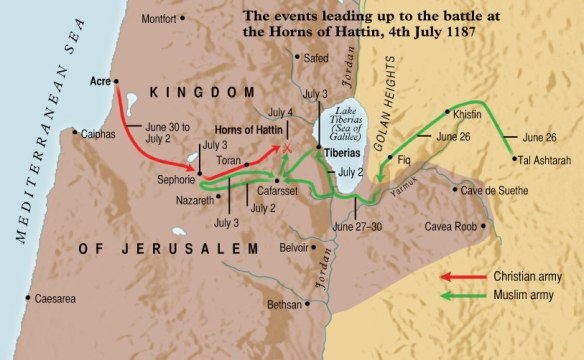
The cause of the war that broke out in 1187 was a raid during a period of truce by Raynald of Châtillon, now lord of Kerak, on a Muslim caravan for which he refused, despite the urgings of King Guy, to pay compensation. But Saladin was already well prepared and his call to jihad was quickly issued. The scale of the threat that he posed was clearly understood, for Raymond of Tripoli renounced his understanding with Saladin after Cresson and became reconciled, at least outwardly, to his bitter enemy King Guy and his supporters, although acute tensions remained. The Franks now made a full muster of all the forces available to the kingdom, about 1,200 knights and 15,000– 18,000 foot and Turcopoles. The figure for cavalry seems reasonable – an amalgam of the forces of the barons and those of the Orders plus mercenaries and pilgrims. But the figure for infantry represents an enormous scale of mobilization. We know that the kingdom could provide 5,000 sergeants, but we can only guess that Guy had called up virtually every able-bodied man, and possibly recruited natives and mercenaries. It was remarkable that a kingdom of this size could produce an army larger than that of Philip Augustus in 1214. It points to the military nature of the Frankish settlement, where every man must have been a soldier. Of course, all Western societies were militarized, but the degree varied according to their situation, and the exposure of the Holy Land to attack meant that it was perhaps the most militarized of all, with every fit man being prepared to serve. Against them, Saladin had mustered 12,000 first-rate cavalry, supported by others and foot, making a total of perhaps 30,000. The crude overall figures indicate a huge numerical advantage to Saladin, but in reality it was far greater, for even if there were as many Turcopoles as heavy cavalry in the Frankish army, he still had four times their numbers of front-line cavalry, and cavalry was the decisive arm. In this light, Frankish losses at the Springs of Cresson seem enormous.
Guy’s army gathered in late June at Saffuriyah, where a castle with ample springs, set in the ruins of an ancient town, offered a good base. Saladin crossed the Jordan just south of the Sea of Galilee on 27 June and then moved up to Kafr Sabt, halfway between Tiberias and Saffuriyah, where he established his main base. After a reconnaissance failed to provoke the Franks to leave Saffuriyah, he attacked Tiberias on 2 July, capturing the town and besieging the wife of Raymond III of Tripoli in the citadel. King Guy called a council of war and on 3 July marched out against Saladin. Historians have devoted enormous attention to this council in order to discover why Guy sallied out from his safe base. Most of our accounts have something to say on this, but Muslim ones are inevitably speculative, while Christian writers were concerned to affix blame on the basis of party allegiances. For example, in both De Expugnatione and the Continuation of William of Tyre, Raymond of Tripoli is portrayed as urging the army to leave his countess to her fate, but other sources suggest that he begged Guy to go to her aid. There is no doubt that the arguments rehearsed in our sources were the kind deployed, but they are probably somewhat simplified and their attribution is highly suspect. In favour of the Fabian tactics so far pursued, it was argued that even if Tiberias fell it would gain Saladin no permanent lodgement, because in time his army would break up: this is a somewhat doubtful argument, because since the Franks had lost the castle at Jacob’s Ford much of Galilee had been devastated and Baisan abandoned, so the fall of Tiberias might well make a permanent lodgement possible. It was certainly true that if Saladin wanted a battle it would be better for the Franks to let his army march around until it could be attacked at a point of their choice, but the price of that in devastation might be very high. Certainly it would be hazardous to attack him before Tiberias, because it was 26km away, with little water along the road. But Guy had to be concerned that a vassal had begged for aid and that an opportunity existed to smash the menace of Saladin once and for all. Moreover, Guy’s Fabian tactics against Saladin’s attacks in 1182 and 1183 had earned him great hostility, so he may have felt the need for a victory. This may have struck a sympathetic note with the barons of Jerusalem, exasperated by Saladin’s harassment and perhaps eager for a settling of scores.